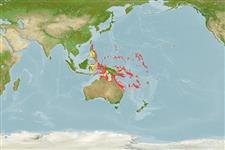Preferred temperature (Fonte Biblio.
123201): 24.7 - 29.5, mean 28 °C (based on 640 cells).
Phylogenetic diversity index (Fonte Biblio.
82804): PD
50 = 0.5000 [Uniqueness, from 0.5 = low to 2.0 = high].
Bayesian length-weight: a=0.00550 (0.00223 - 0.01355), b=3.27 (3.06 - 3.48), in cm total length, based on LWR estimates for this (Sub)family-body shape (Ref.
93245).
Trophic level (Fonte Biblio.
69278): 3.3 ±0.4 se; based on size and trophs of closest relatives
Resilienza (Fonte Biblio.
120179): Medio, tempo minimo di raddoppiamento della popolazione 1.4 - 4.4 anni (Fec = 1,363).
Fishing Vulnerability (Ref.
59153): Low vulnerability (10 of 100).
🛈
Nutrients (Ref.
124155): Calcium = 320 [148, 805] mg/100g; Iron = 1.55 [0.70, 3.01] mg/100g; Protein = 18.3 [16.9, 19.7] %; Omega3 = 0.113 [0.045, 0.296] g/100g; Selenium = 44.5 [13.8, 127.2] μg/100g; VitaminA = 75.8 [17.5, 319.4] μg/100g; Zinc = 3.49 [1.92, 5.67] mg/100g (wet weight);
